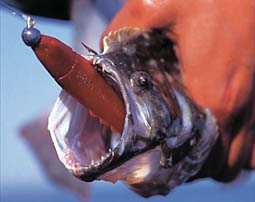|
|

|
 |
 | ||
Good News for Texas Flounder Fishers
They are as bizarre-looking as saltwater fish can get, right in there with such outlandishly freakish coastal oddities as the dogfish, sea robin, cutlassfish and puffer. Difference is, flounder are also some of the finest eating fish you'll find in their entire home range - which is, no doubt, what got them into trouble in the first place.
According to Gene McCarty, Director of Coastal Fisheries for the Texas Parks and Wildlife Department, their concern was all too justifiable. "We were seeing a number of serious problems in the population," McCarty recalls. "First, we had a fairly dramatic decline in availability, the total number of fish out there. We'd seen several years in a row of bad recruitment, a period during which the population was not producing a sizable number of juvenile fish. And," the veteran biologist adds, "we were seeing a decrease in the mean size of the fish as well." Collectively, McCarty points out, all of those factors combined indicated "a pretty classic representation of an overfishing condition." And, he says, that is what drove the department to make the first round of recommendations for increased regulatory management of the Texas flounder fishery. Flounder regulations were indeed changed, effective September 1st of last year. "We changed the minimum length limit from 12 inches to 14 inches, and we decreased the bag and possession limits as well," McCarty notes, "from 20 fish in the bag to 10 fish in the bag and 40 in possession to 20 in possession. And for the first time, we enacted a possession limit for commercial fishermen (60 fish per day)." How long, I ask, before we'll see the results? "It's a little bit too early on availability," McCarty replies. "The regulations which went into effect last September protected last year's spawning run. And we are already seeing improved recruitment this year. With the 14-inch length limit in place, we protected more adult fish, allowing them to go to the Gulf and spawn. "As such," he continues, "there were more offspring which returned to the bays." Perhaps the most promising harbinger of improved fall flatfishing this year rests in the fact that as a result of the Sept. 1, '96 size change, the fish that last autumn measured between 12 and 14 inches were released. A bunch of those will certainly be harvested this year, at a size that will do a much better job of filling out a baking pan. And again, McCarty stresses that recruitment - the producing of juvenile fish - will also benefit greatly from the minimum size increase. "Probably the bulk of the spawning population comes from the smaller-sized fish in the first year of spawning," he says. "A 14-inch flounder is a 2-year-old fish, and one that's capable of producing lots and lots of offspring." Are further regulations in store? "We're going to give it another year and see what the population structure looks like while simultaneously looking at some other sources of mortality such as (shrimping) bycatch," McCarty says. "There may be some additional altering of the bag if we don't see a pretty good turn-around from the current regulations. Twenty fish in possession and 10 in the bag is still an awful lot of fish (and so is, I might add, 60 fish in possession for the commercial fishing fraternity). "However," he adds, "all the biology that we have on these fish tells us that the 14-inch length limit should work as well for flounder as the 15-inch length limit did for the spotted seatrout ("speckled trout," to us non-biologist types). We're basically looking at the same biological characteristics; for example, the bulk of the female population becomes sexually mature at 14 inches. The added protection of increased length limits should dramatically improve recruitment. "I think we're going to see some real productive results, that these regulations changes are going to have a very positive impact on fishing success," McCarty comments. "We're hearing that this year is shaping up to be pretty good. People are already reporting seeing a lot of fish. And a lot of that could be simply from saving those 12- to 14-inch flounder last year. "I can't say enough about what length limits do," McCarty concludes. "Everybody kind of bemoaned the 15-inch length limit on spotted seatrout. Now, everybody just swears by it. The result is that speckled trout populations are now as good as they've been since - gosh, I can't even count back that far." Hopefully - and in all likelihood, given McCarty's impressive track record for accuracy on such matters - it won't be long before we can say the same about the state's flounder fishery. | |
|
| |
Site design by Copyright © 1996-2007 Outdoor Management Network Inc. America Outdoors® is a registered trademark of Outdoor Management Network Inc. |
 One-year-old regs bode well for '97 flatfish run
One-year-old regs bode well for '97 flatfish run